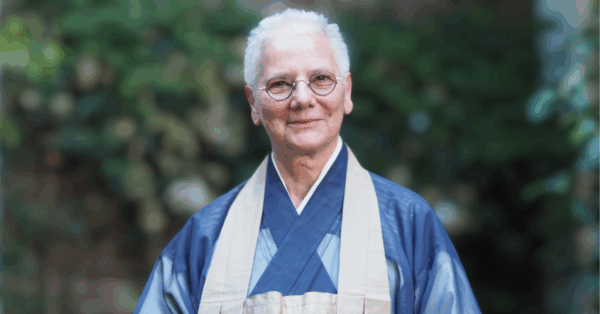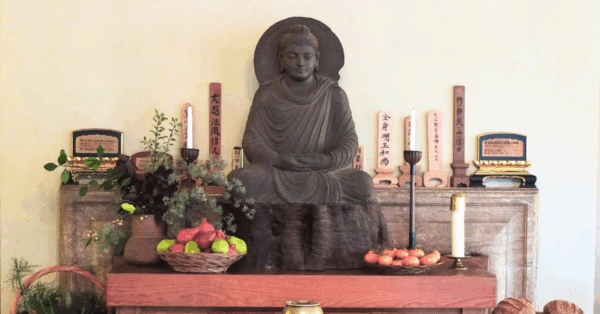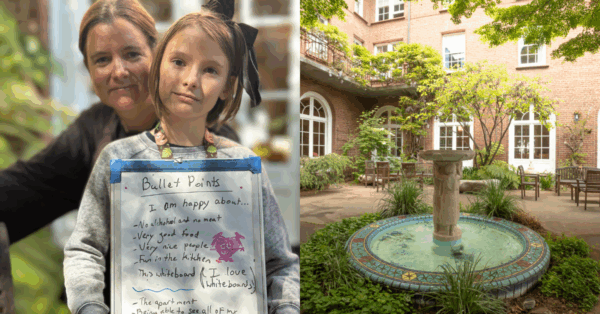
Photos by Meiya Wender
By Tova Green
Zenshuji, a Soto Zen temple in Los Angeles, celebrated the 100th anniversary of its founding throughout 2022, culminating in November with a Jukai-e, five days of zazen, study, ceremonies and Dharma talks which brought together teachers and students from many parts of North America and the wider world. Plans for the anniversary events began three years earlier and a core group of Zen teachers rehearsed for the Jukai-e for a year, meeting frequently at Zenshuji for several days of practice together.
The Abbot of Zenshuji, Rev. Shumyo Kojima wrote in a handbook for participants, ”One hundred years ago, on November 20, 1922, a small Zen group was born in the city of Los Angeles, after the Spanish flu had finally been contained. This group rented a space on the second floor of a private house and put up a sign which said ‘Soto Zen Buddhism North America Buddhist Church.’ Then they built an assembly hall and named it ‘Zenshuji.’ After completing construction of the temple they offered a commemoration service for their ancestors and a Jukai-e ceremony where they gave the precepts and the Kechimyaku, karmic connection charts, to the people. That’s how Soto Zen Buddhism in North America was born.”
The Jukai-e, from ancient times, has been an important practice within the Soto Zen school of Buddhism and is conducted at Eiheiji and Sojiji in Japan, as well at many other Soto Zen temples around the world.
Several SFZC teachers and leaders of some Branching Streams sanghas had important roles in the ceremony, including Senior Dharma Teacher Tenshin Reb Anderson, Houston Zen Center’s Abbot Konjin Gaelyn Godwin, Berkeley Zen Center’s Abbot Hozan Alan Senauke, co-founding teachers of Ocean Gate Zen Center Shinshu Roberts and Daijaku Kinst, and Shosan Victoria Austin and Meiya Wender from San Francisco Zen Center. SFZC’s President Sozan Miglioli took part in the doanryo, sounding bells during the ceremonies.
In addition, five SFZC students, Kodo Conlin, Heather Iarusso, Barbra Machtinger, Michael McCord, and Catherine Spaeth were among the nearly 100 Soto Zen students from different lineages who received the precepts. After they returned, they shared some of their impressions with the City Center sangha.
Soren Heather Iarusso: “What stood out for me was the pageantry, precision, and coordination of the four-and-a-half days of ceremonies and services. The entire series of ceremonies created a container akin to sesshin with the one body-mind of the assembly flowing and settling together. It was like meditation in motion. And it was wonderfully uplifting to be with all these bodhisattvas from around the world as we vowed together—new and old friends—to save all beings.”
“It was one of the most amazing ceremonial experiences I’ve had,” said Kodo Conlin. “I was seated next to my Tassajara tangaryo roommate, Ian Case (who now practices at Ancestral Heart, the monastery connected to Brooklyn Zen Center). There was a feeling that we were one Zen family from all over the U.S. and the world.” In addition to the ceremonies, Kodo appreciated the six formal talks on the precepts and six informal talks on the paramitas.
“The ceremonies flowed, and were flawless,” said Barbara Machtinger. “The organizers worked hard, were up late planning, and missed meals.” Barbara found Ejo McMullin, who led the group from event to event, to be delightful, gracious, kind and efficient.
Catherine Spaeth, who had stayed at Ejo McMullin’s temple Dharma Eye in Eugene, OR, appreciated his “pioneering Zen spirit.” She noticed the strong participation of women teachers in the ceremonies and dharma talks. “We were celebrating women’s part in American Zen.”
“It was like watching a cast do four or five Broadway plays each day for five days. Each ceremony was unique and complex,” said Michael McCord.
Shosan Victoria Austin commented that “it’s important to learn through the body how Japanese people work together harmoniously. The ceremonies gave me an understanding of the international spreading of Soto Zen.”











